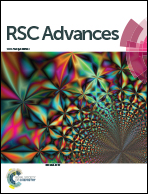Dissociation reaction of B2H6 on TiN surfaces during atomic layer deposition: first-principles study†
Abstract
In the fabrication process of memory devices, a void-free tungsten (W) gate process with good conformability is very important for improving the conductivity of the W gate, leading to enhancement of device performance. As the downscaling continues to progress, void-free W deposition becomes more difficult due to the experimental limitations of conformal film deposition even with atomic layer deposition (ALD) W processes. In ALD W processes, it is known that the B2H6 dosing process plays a key role in deposition of the ALD W layer with low resistivity and in removal of residual fluorine (F) atoms. To comprehend the detailed ALD W process, we have investigated the dissociation reaction of B2H6 on three different TiN surfaces, TiN (001), Ti-terminated TiN (111), and N-terminated TiN (111), using first-principles density functional theory (DFT) calculations. N-terminated TiN (111) shows the lowest overall reaction energy for B2H6. These results imply that severe problems, such as a seam or void, in filling the W metal gate for memory devices could be attributed to the difference in the deposition rate of W films on TiN surfaces. From this study, it was found that the control of the texture of the TiN film is essential for improving the subsequent W nucleation.



 Please wait while we load your content...
Please wait while we load your content...